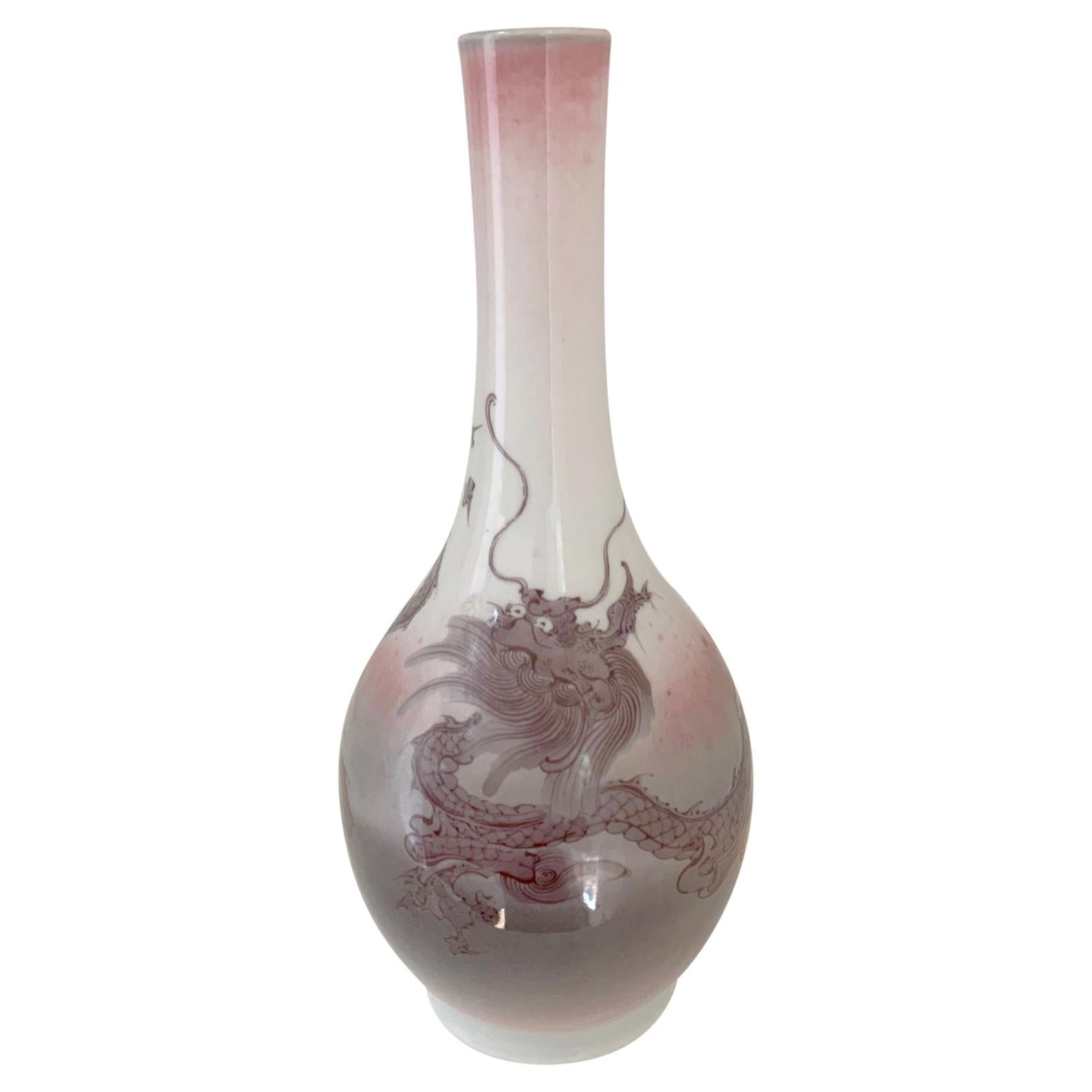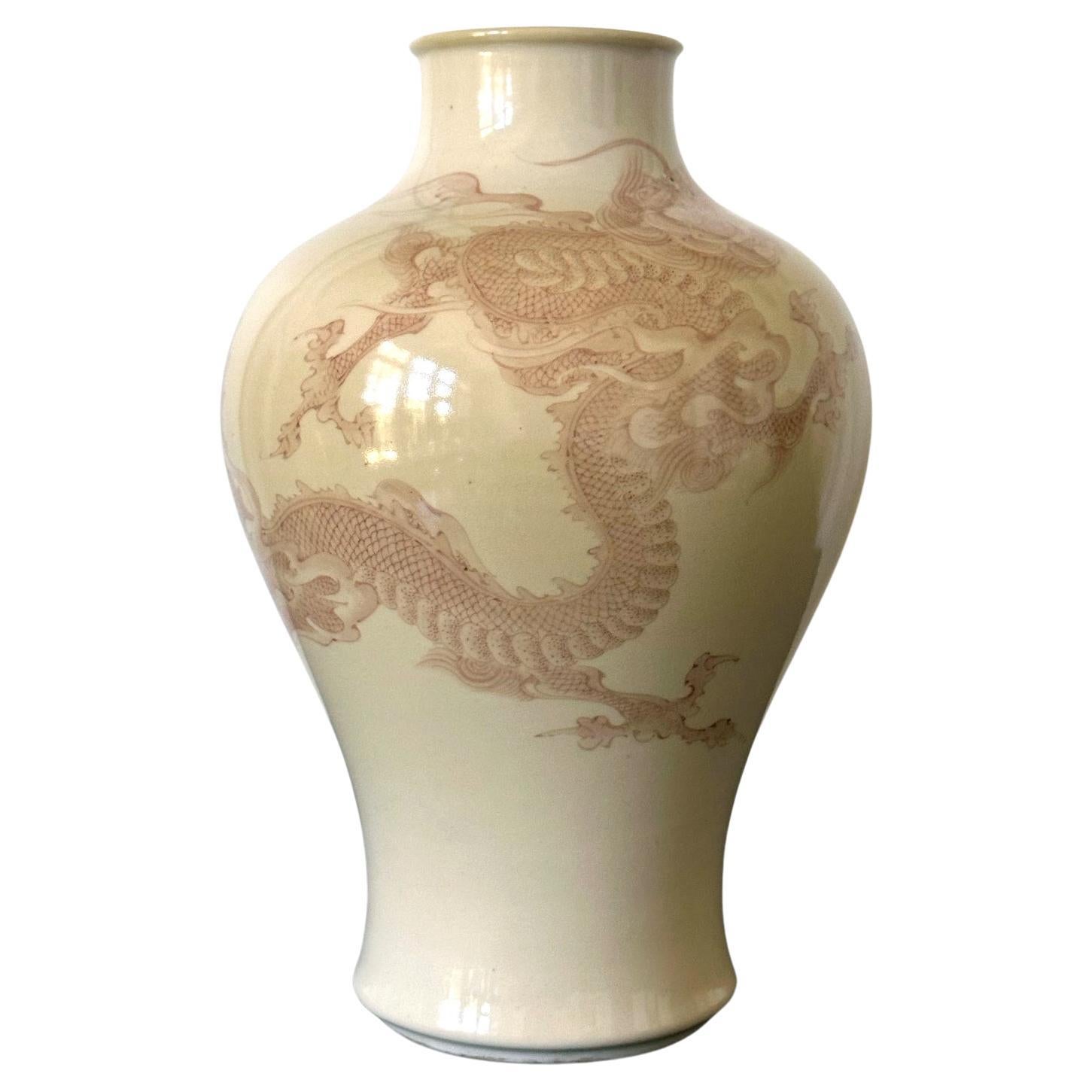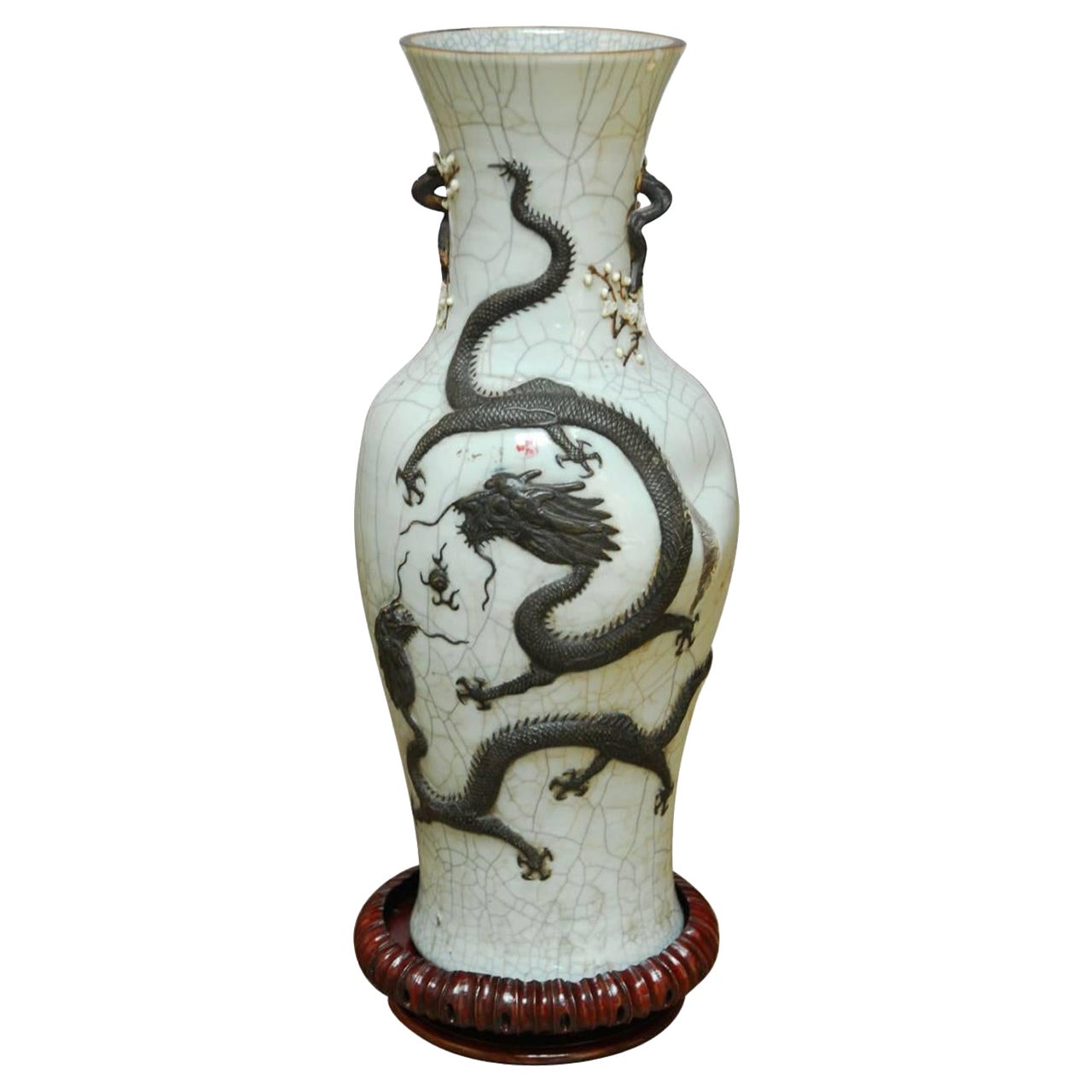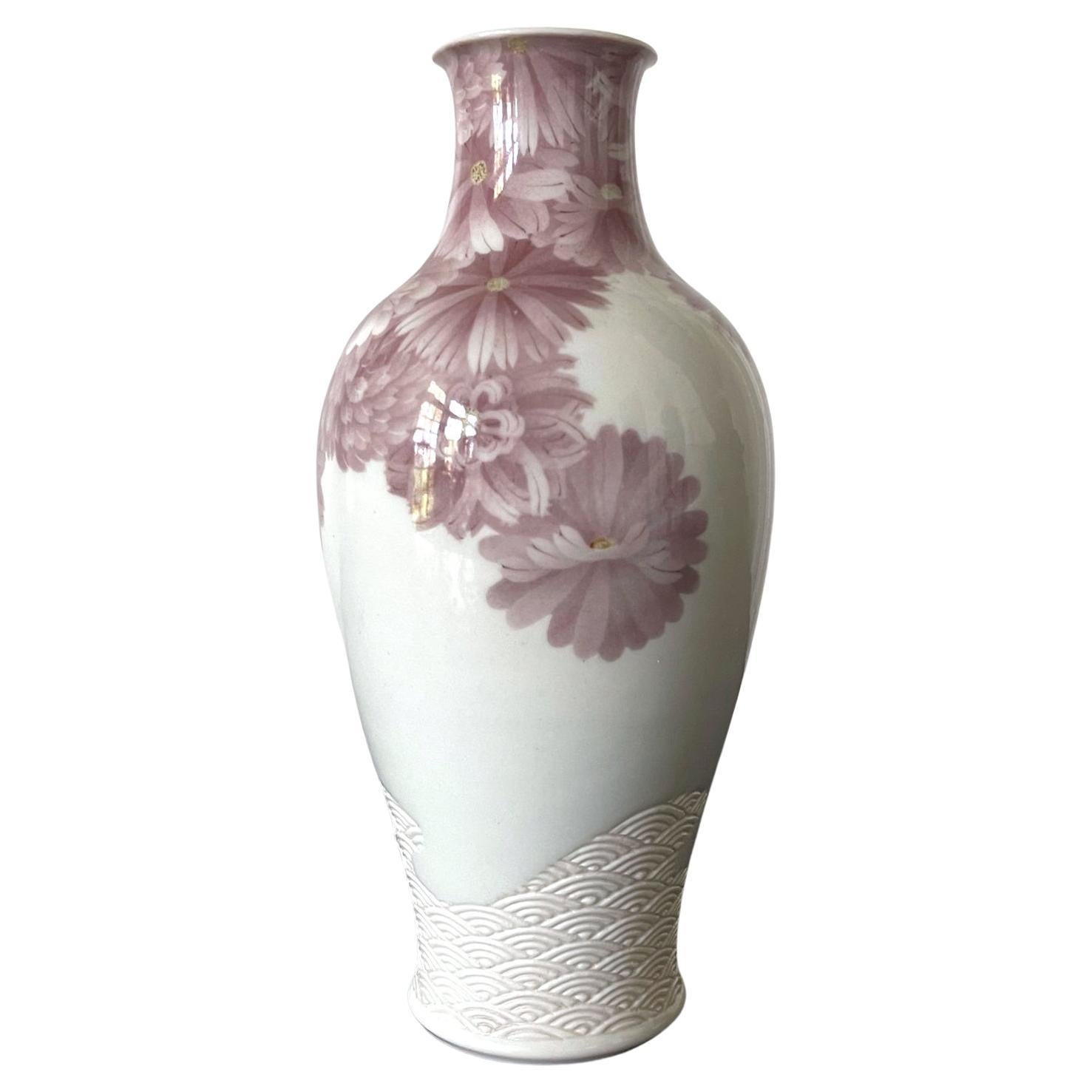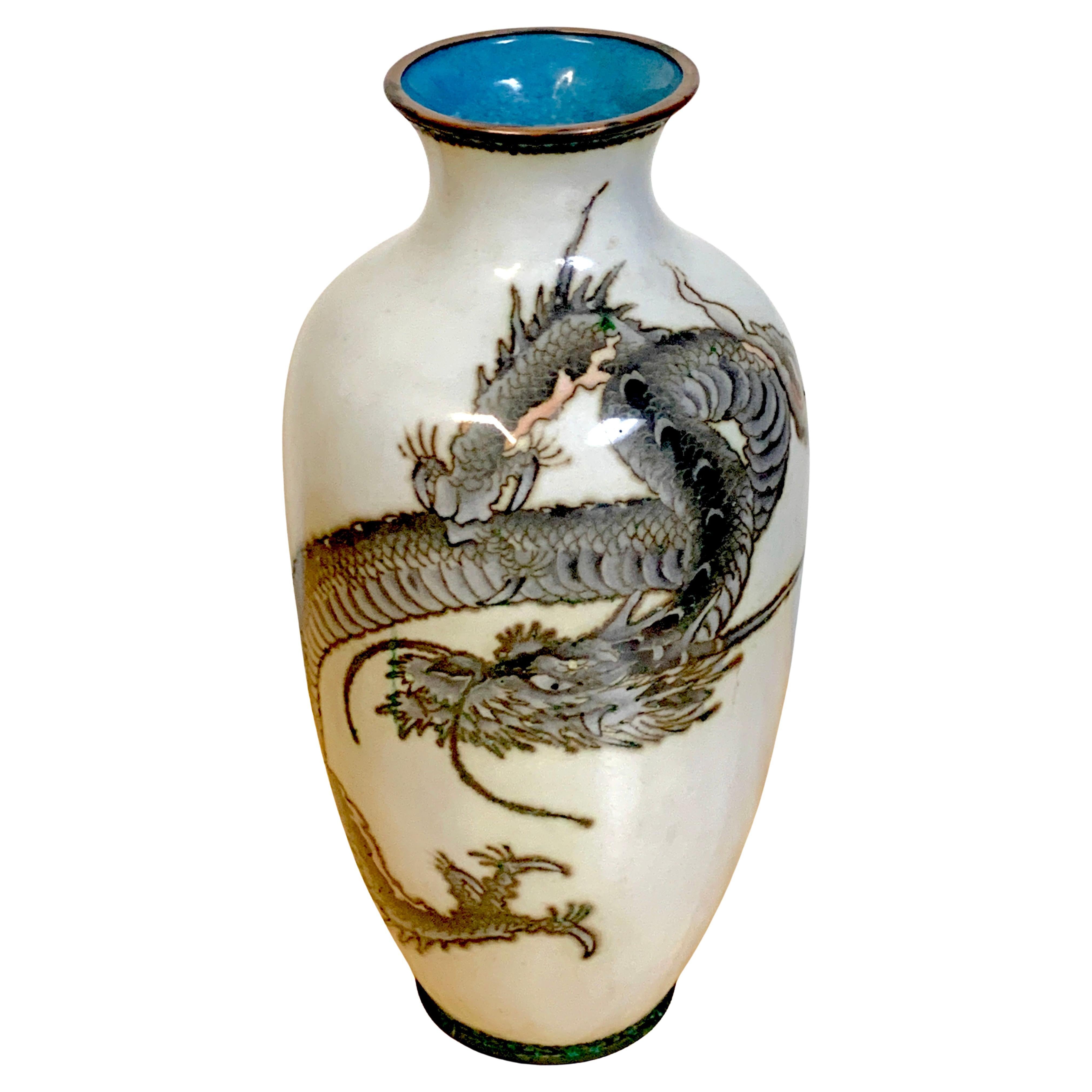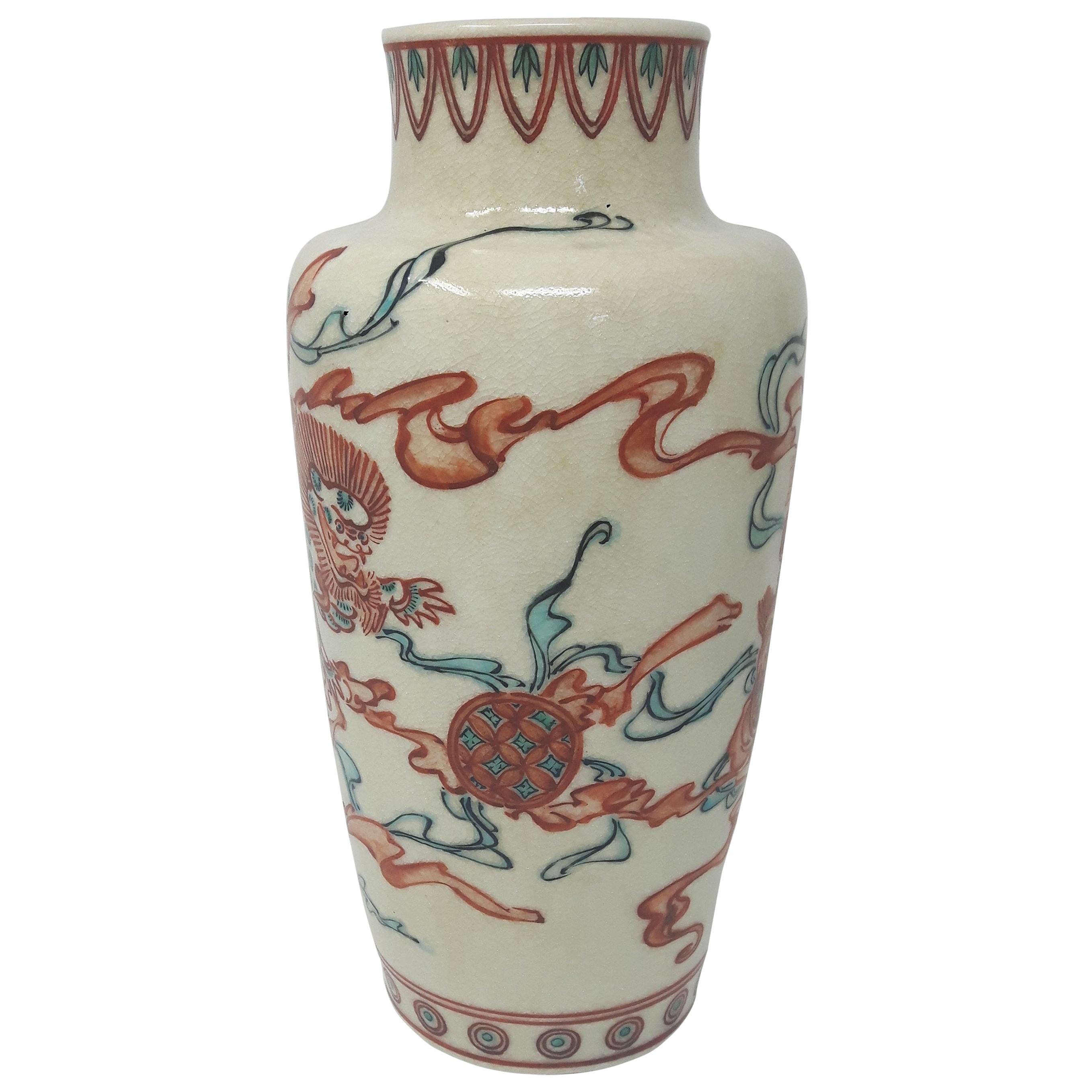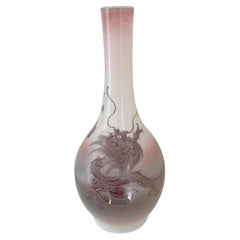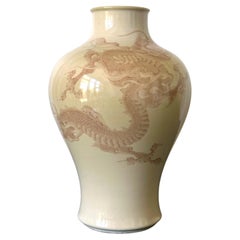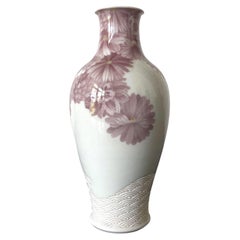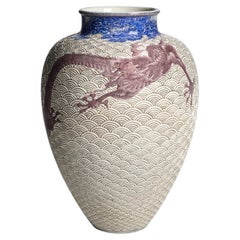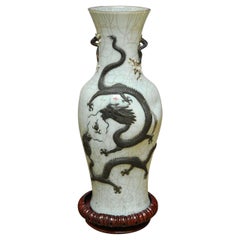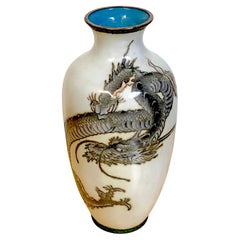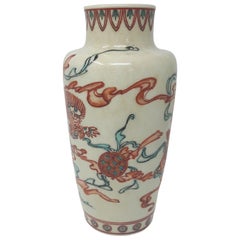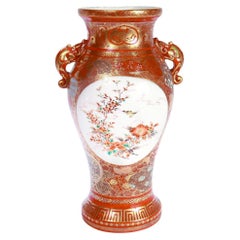Items Similar to Japanese Porcelain Glazed Vase with Dragon Design Mazuku Kozan
Want more images or videos?
Request additional images or videos from the seller
1 of 17
Japanese Porcelain Glazed Vase with Dragon Design Mazuku Kozan
$6,800
£5,198.96
€5,988.15
CA$9,528.88
A$10,638.10
CHF 5,574.21
MX$130,220.83
NOK 70,792.48
SEK 66,748.32
DKK 44,690.21
Shipping
Retrieving quote...The 1stDibs Promise:
Authenticity Guarantee,
Money-Back Guarantee,
24-Hour Cancellation
About the Item
A porcelain vase with dragon design by Japanese imperial potter Makuzu Kozan (1842-1916), circa 1900s. The vase is made in what is considered early phase of his underglaze period during late Meiji era. In a classic baluster form, the surface of the vase was decorated with a slithering dragon in underglaze iron red circulating the exterior among pink clouds. The animated rendering of the dragon is fine and detailed, with five claws, scales, long tails and highlighted eyes. The pink cloud is misty and called Morotai or the hazy style, created with a unique technique developed in Kozan's studio called fuki-e by blowing the pigment powders onto the surface. Kozan Studio experimented with newly available colors from the west starting in the 1880s, which resulted in the expansion of the palette and style that bridged the east and west aesthetic tradition. Marked in underglaze blue on the base.
Known also as Miyagawa Kozan (1842-1916), he is one of the most established and collected ceramist from Meiji Period. Born as Miyagawa Toranosuke, Kozan established his pottery studio in Yokohama circa 1870s and later became one of the appointed artists to the Japanese Imperial household. His work was exhibited in many international fairs that the Meiji government participated at the turn of the century and won many grand prizes.
For a very similar vase, see page 98 illustrate 39 in "Makuzu Ware" by Dr. Yamamoto.
- Creator:Makuzu Kozan (Artist)
- Dimensions:Height: 9.3 in (23.63 cm)Diameter: 5.5 in (13.97 cm)
- Style:Japonisme (Of the Period)
- Materials and Techniques:
- Place of Origin:
- Period:1900-1909
- Date of Manufacture:1890s-1900s
- Condition:Wear consistent with age and use. Fine condition with minimal wear.
- Seller Location:Atlanta, GA
- Reference Number:1stDibs: LU945028901992
About the Seller
4.9
Platinum Seller
Premium sellers with a 4.7+ rating and 24-hour response times
Established in 2006
1stDibs seller since 2010
564 sales on 1stDibs
Typical response time: <1 hour
- ShippingRetrieving quote...Shipping from: Atlanta, GA
- Return Policy
Authenticity Guarantee
In the unlikely event there’s an issue with an item’s authenticity, contact us within 1 year for a full refund. DetailsMoney-Back Guarantee
If your item is not as described, is damaged in transit, or does not arrive, contact us within 7 days for a full refund. Details24-Hour Cancellation
You have a 24-hour grace period in which to reconsider your purchase, with no questions asked.Vetted Professional Sellers
Our world-class sellers must adhere to strict standards for service and quality, maintaining the integrity of our listings.Price-Match Guarantee
If you find that a seller listed the same item for a lower price elsewhere, we’ll match it.Trusted Global Delivery
Our best-in-class carrier network provides specialized shipping options worldwide, including custom delivery.More From This Seller
View AllJapanese Porcelain Dragon Glazed Vase Mazuku Kozan
By Makuzu Kozan
Located in Atlanta, GA
A porcelain vase with dragon motif by Japanese imperial potter Makuzu Kozan (1842-1916), circa 1900s. The vase is made in what is considered early phase of his underglaze period during late Meiji era. In a classic elongated baluster form, the surface of the vase was decorated in an unusual pink mist on a white and aubergine background (called Morotai, the Hazy style), on which a flying dragon is showcased on the center. The dragon was outlined in iron red and filled with the aubergine color and was artistically emphasized on its bulging eyes, claws, scales and a long tail. It was the sole focus of the design circumventing the entire body of the vase. The imagery calls in mind the dragon decoration found in Korean...
Category
Antique Early 1900s Japanese Japonisme Ceramics
Materials
Porcelain
Large Japanese Porcelain Dragon Vase by Makuzu Kozan Meiji Period
By Makuzu Kozan
Located in Atlanta, GA
Made by the studio of the legendary Japanese imperial potter Makuzu Kozan (1842-1916), this is a large porcelain vase glazed in a soft yellow color with a subtle gradient, on top of ...
Category
Early 20th Century Japanese Meiji Ceramics
Materials
Ceramic
Japanese Ceramic Vase with Delicate Carvings by Makuzu Kozan Meiji Period
By Makuzu Kozan
Located in Atlanta, GA
A delicate and rare Japanese ceramic vase by the important Meiji imperial potter Makuzu Kozan (1842-1916) circa 1887-1910. Dated to his underglaze phase post 1887 after he successful...
Category
Antique 1890s Japanese Japonisme Ceramics
Materials
Ceramic
Large Japanese Ceramic Vase by Makuzu Kozan Meiji Period
By Makuzu Kozan
Located in Atlanta, GA
A large Japanese ceramic vase by the celebrated Meiji imperial potter Makuzu Kozan (1842-1916) circa 1880-1890s. Dated to his underglaze phase post 1887 after he successfully mastered the new colors available from the west and used them to the best advantage in his work deeply rooted in Japanese aesthetics. The vase has an impressive size and was potted in the classic baluster form with an elegant proportion. The surface is decorated using a combination of techniques of low relief sculpturing...
Category
Antique Late 19th Century Japanese Meiji Ceramics
Materials
Ceramic
Fine Japanese Ceramic Vase Makuzu Kozan Meiji Period
By Makuzu Kozan
Located in Atlanta, GA
A Japanese long neck porcelain vase circa 1900-1910s by the studio of Miyagawa Kozan (1842–1916), one of the most established and collected Japanese ceramist from the end of Meiji Period. Commonly known as Makuzu Kozan, which also appears as the signature on his work, his originally birth name was Miyagawa Toranosuke. He was the appointed artist to the Japanese Imperial household and his work was exhibited in many international fairs that the Meiji government participated at the turn of the century.
This vase features an elegant Classic form with a slender neck and slightly flared mouth above a baluster body. It was finely painted with two swimming carps in a copper red underglaze among green ribbons like waves. The background display a brilliant verdant green overall, Around the fish a poetic hazy effect was emphasized for a visual complexity by Fuki-e (the blow painting), an invention in Kozan's studio. The new technical development of chemical colors from the west was embraced circa 1900s in Kozan studio. This empowered the more creative experiments with not only colors, but also concept of dimension, which led Makuzu Kozan's work to become a bridge between East and West aesthetics. This is particularly evident in this vase with the Masterly details of the brush strokes, the expertly employment of gradient of color, and a very realistic and detailed rendering of the fish and their vivid motions.
For two similar examples of Kozan's work with similar carps decoration, see Page 148-149 of the book: Sekai ni Aisa Reta ya Kimono Miyagawa Kozan Makuzu...
Category
Early 20th Century Japanese Meiji Ceramics
Materials
Ceramic
Japanese Porcelain Vase with Relief Surface Makuzu Kozan
By Makuzu Kozan
Located in Atlanta, GA
A rare porcelain vase by Makuzu Kozan (1842-1916) circa 1870-81 (late Meiji period). The vase is dated to the earlier work from Kozan's studio during his early period (Takauki-ware p...
Category
Antique Late 19th Century Japanese Japonisme Ceramics
Materials
Ceramic
You May Also Like
Chinese Qing Dynasty Crackle Glazed Dragon Vase with Kiln Error
Located in Rio Vista, CA
20th century rare Qing dynasty crackled (GE) glazed vase with molded three dimensional dragon forms. This very fine quality vase is particularly interesting by the presence of a kiln...
Category
Early 20th Century Chinese Qing Ceramics
Materials
Earthenware, Porcelain
$1,800 Sale Price
35% Off
Exquisite Japanese Wireless Cloisonné Dragon Motif Vase, Meiji / Taisho Period
Located in West Palm Beach, FL
Japanese Wireless Cloisonné Enamel Vase, likely from the Meiji period (1868–1912) or possibly the early Taisho period (1912–1926). The vase features a dynamic depiction of a Japanese...
Category
Early 20th Century Japanese Meiji Vases
Materials
Copper
Unusual Early 20th Century Makuzu Kozan Vase
By Makuzu Kozan
Located in London, GB
Decorated in iron-red and green enamels with an overall design of three shish frolicking with a brocade ball, signed on the base with an impressed seal Makuzu.
The storage box ti...
Category
Early 20th Century Japanese Meiji Ceramics
Materials
Porcelain
Antique Japanese Meiji Period Kutani Porcelain Vase by Shoundo / Matsumoto Sahei
Located in Philadelphia, PA
A fine antique Japanese Meiji period Kutani porcelain vase.
By Matsumoto Sahei/Shoundo.
In an aka-e style decorated throughout in iron red with extensive gilt accents.
There are cartouches to either side both with branches of red flower with a backdrop of clouds on a white ground.
With 2 figural dragon finial handles.
Marked to the base with '九谷松雲堂製' which translates as 'Made by Shoundo of Kutani'
Matsumoto Sahei (1851-1918) was a master potter who enjoyed success & recognition during his era. In 1876, Sahei received the artist name Shoundo from the nanga painter Tokuda Kansho - he would use that title for nearly 20 years until passing it onto his son as his successor in 1893. Sahei also has the distinction of taking Tokuda Yasokichi I as an apprentice when the latter was 17-years-old. The Tokuda family is perhaps one of the most famous families of Japanese ceramics: Yasokichi I is credited with revitalizing the lost art of ko-Kutani and Yasokichi I, II, & III were all recognized as "Living National Treasures" during their lifetimes.
Shoundo exhibited internationally numerous times at the tail end of the 19th Century. The Keisei Isogaya Museum of Art (which specializes in Meiji Kutani) has a vase of Sahei's that was exhibited in the Philadelphia Centennial Exhibition of 1876. He is listed as exhibiting a wide variety of porcelain goods at the 1878, 1889, and 1900 Paris World Exhibitions. He is also listed as exhibiting 'incense burners & porcelain' at the World's Columbian Exhibition held in 1893 in Chicago. The pair of vases that Sahei exhibited in Paris in 1900 bear a strong resemblance to this pair.
Simply a wonderfully rare Japanese porcelain...
Category
Early 20th Century Japanese Meiji Ceramics
Materials
Porcelain
Japanese Satsuma Dragon Vase, Meiji Period, c 1900, Japan
By Satsuma
Located in Austin, TX
A fantastic small Japanese Satsuma vase with image of writhing dragons, Meiji Period, circa 1900, Japan.
The vase of elegant baluster form, with a slightly flared foot, slender body...
Category
Antique Early 1900s Japanese Meiji Ceramics
Materials
Ceramic, Porcelain, Pottery, Stoneware, Hardwood
Antique Japanese Moriage Nippon Porcelain Vase or Covered Jar
Located in Philadelphia, PA
A fine antique Japanese Nippon porcelain vase or covered urn.
With green, pink, and white tones in raised moriage enamel that gives a three-dimensional effect.
Decorated with 4 cartouches throughout. The main cartouche features a moriage dragon...
Category
20th Century Japanese Meiji Ceramics
Materials
Enamel
More Ways To Browse
Antique Glazed Vases
Japanese Dragon
Porcelain Dragons
Blue Glaze Japan
Antique Japanese Dragon
Antique Iron Glaze
Porcelain Japanese 1900
Iron Dragon
Japanese Vases With Dragons
Antique Porcelain Fairings
Pink Asian Vase
Circa 1900 Japanese Vase
Japanese Blue Dragon
Blue Dragon Porcelain Vases
Powder Blue Vase
Dragon Pottery
Powder Blue Porcelain
Dragon Ware
